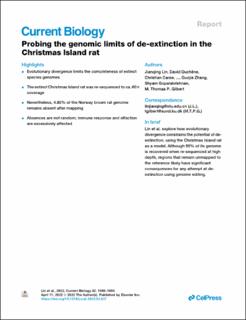Probing the genomic limits of de-extinction in the Christmas Island rat
| dc.contributor.author | Lin, Jianqing | |
| dc.contributor.author | Duchêne, David | |
| dc.contributor.author | Carøe, Christian | |
| dc.contributor.author | Smith, Oliver | |
| dc.contributor.author | Ciucani, Marta Maria | |
| dc.contributor.author | Niemann, Jonas | |
| dc.contributor.author | Richmond, Douglas | |
| dc.contributor.author | Greenwood, Alex D. | |
| dc.contributor.author | MacPhee, Ross | |
| dc.contributor.author | Zhang, Guojie | |
| dc.contributor.author | Gopalakrishnan, Shyam | |
| dc.contributor.author | Gilbert, Marcus Thomas Pius | |
| dc.date.accessioned | 2023-02-21T12:00:58Z | |
| dc.date.available | 2023-02-21T12:00:58Z | |
| dc.date.created | 2022-05-04T15:00:33Z | |
| dc.date.issued | 2022 | |
| dc.identifier.citation | Current Biology. 2022, 32 (7), 1650-1656. | en_US |
| dc.identifier.issn | 0960-9822 | |
| dc.identifier.uri | https://hdl.handle.net/11250/3052724 | |
| dc.description.abstract | Three principal methods are under discussion as possible pathways to “true” de-extinction; i.e., back-breeding, cloning, and genetic engineering.1,2 Of these, while the latter approach is most likely to apply to the largest number of extinct species, its potential is constrained by the degree to which the extinct species genome can be reconstructed. We explore this question using the extinct Christmas Island rat (Rattus macleari) as a model, an endemic rat species that was driven extinct between 1898 and 1908.3, 4, 5 We first re-sequenced its genome to an average of >60× coverage, then mapped it to the reference genomes of different Rattus species. We then explored how evolutionary divergence from the extant reference genome affected the fraction of the Christmas Island rat genome that could be recovered. Our analyses show that even when the extremely high-quality Norway brown rat (R. norvegicus) is used as a reference, nearly 5% of the genome sequence is unrecoverable, with 1,661 genes recovered at lower than 90% completeness, and 26 completely absent. Furthermore, we find the distribution of regions affected is not random, but for example, if 90% completeness is used as the cutoff, genes related to immune response and olfaction are excessively affected. Ultimately, our approach demonstrates the importance of applying similar analyses to candidates for de-extinction through genome editing in order to provide critical baseline information about how representative the edited form would be of the extinct species. | en_US |
| dc.language.iso | eng | en_US |
| dc.publisher | Elsevier | en_US |
| dc.rights | Attribution-NonCommercial-NoDerivatives 4.0 Internasjonal | * |
| dc.rights.uri | http://creativecommons.org/licenses/by-nc-nd/4.0/deed.no | * |
| dc.title | Probing the genomic limits of de-extinction in the Christmas Island rat | en_US |
| dc.title.alternative | Probing the genomic limits of de-extinction in the Christmas Island rat | en_US |
| dc.type | Peer reviewed | en_US |
| dc.type | Journal article | en_US |
| dc.description.version | publishedVersion | en_US |
| dc.source.pagenumber | 1650-1656 | en_US |
| dc.source.volume | 32 | en_US |
| dc.source.journal | Current Biology | en_US |
| dc.source.issue | 7 | en_US |
| dc.identifier.doi | 10.1016/j.cub.2022.02.027 | |
| dc.identifier.cristin | 2021504 | |
| cristin.ispublished | true | |
| cristin.fulltext | original | |
| cristin.qualitycode | 2 |
Tilhørende fil(er)
Denne innførselen finnes i følgende samling(er)
-
Institutt for naturhistorie [1213]
-
Publikasjoner fra CRIStin - NTNU [37304]

